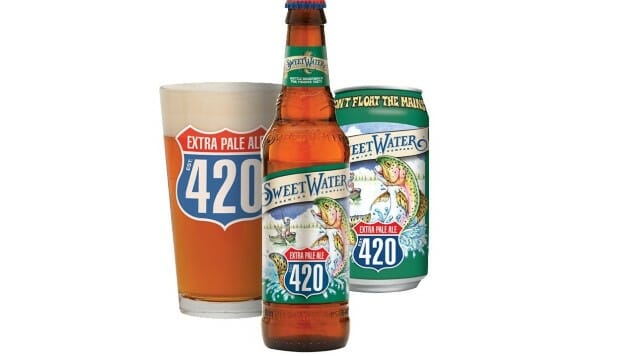My Month of Flagships: SweetWater Brewing Co. 420 Extra Pale Ale
Photos via SweetWater Brewing
This essay is part of a series this month, coinciding with the concept of Flagship February, wherein we intend to revisit the flagship beers of regional craft breweries, reflect on their influence within the beer scene, and assess how those beers fit into the modern beer world. Click here to see all the other entries in the series.
If you’ve lived as a craft beer fan in a few different regions of the country, you begin to realize that the nation’s beer awakening didn’t exactly all happen at once. Driven partially by regional trends, and partially by restrictive laws that in some cases took ages to bring into line with national standards, some areas of the U.S. simply took longer to fully embrace craft beer than others. The Southeast, for example, was notably slower than other major regions, and it might have been slower still if not for the founding of SweetWater Brewing Co. back in 1997. There were only three other Atlanta-area breweries at the time, only one of which (Atlanta Brewing Co.) still exists today. But none of the era ultimately made such a big impact on the region as SweetWater, which today stands as the largest craft brewery in the Southeast. And no beer was more important to that ascent than the flagship, 420 Extra Pale Ale.
Yeah, it was stoner jokes from the start at SweetWater, which has long gone toe-to-toe with Oskar Blues for the title of “dankest regional craft brewery.” 420 was an early creation, introduced at a time when drinking at the company’s taproom was actually free, if you can believe that—founder Freddy Bensch once told me in a different Paste history that back in those halcyon days they figured “if you’re brave enough to come out here, you should get some beer for it.” At the time, it was a beer that was more profoundly hop forward than almost anyone in Atlanta had ever experienced before, and it was instrumental in building the city’s appreciation for hops.
420 is also one of those brands that arguably became better known on its own than brewery from which it hails—the class of brewery flagships known by a single name, like the “Cher” of its region. The full name is 420 Extra Pale Ale, but I can say with some degree of experience that in years of living in Atlanta I don’t think I ever heard anyone actually say those words. It’s just “420,” that beer with its own festival, always being mistaken for an IPA. Hell, I’ve frequently seen it listed as an IPA on bar menus, or described as such by longtime drinkers, despite the fact that SweetWater’s other most visible beer over the years has literally been named SweetWater IPA. But 420 is a unique animal.
It’s also one of my favorite cases for illustrating that beer recipes are, in most cases, a living document. Many breweries will make the claim that their flagship or most popular beer represents some kind of sacred covenant that must not be tampered with—that to adjust the recipe would be tantamount to disrespecting all of their longtime customers. The reality is much closer to how Bensch describes it, that recipe tweaking is an integral facet in keeping a beer consistent. Also: No matter how much people tell you that they love your older core recipe, it pays to keep modernizing it to suit the era in which it’s being sold. As Bensch put it, back in 2017:
“Okay, we really change it four times a year, but here’s why. You’re never getting the same exact ingredients every year, because each hop crop and barley crop after different. It’s as simple as that. You constantly have to work with those new hop crops to get the beer back to where you want it to be. With that said, comparing 420 now vs. 420 from two decades ago, it’s way hoppier now. The customer’s palate is completely different, which we were acknowledging when we started dry hopping it four years ago.”
That’s the sort of pragmatism I’ve always appreciated from SweetWater, and although my go-to was usually SweetWater IPA rather than 420 over the years, you can’t cover beer in Atlanta for any amount of time without realizing just how much this particular extra pale ale has meant to so many people.
-

-

-

-

-

-

-

-

-

-

-

-

-

-

-

-

-

-

-

-

-

-

-

-

-

-

-

-

-

-

-

-

-

-

-

-

-

-

-

-








































